MTD Yardworks 60-1620-4 User Manual

OWNER’S MANUAL
21” Gas-powered Push Mower
Model 60-1620-4
IMPORTANT:
READ ALL SAFETY
RULES AND INSTRUCTIONS
CAREFULLY BEFORE
OPERATING THIS EQUIPMENT.
FOR ASSISTANCE CALL 1-866-523-5218
769-02968A 11.5.07
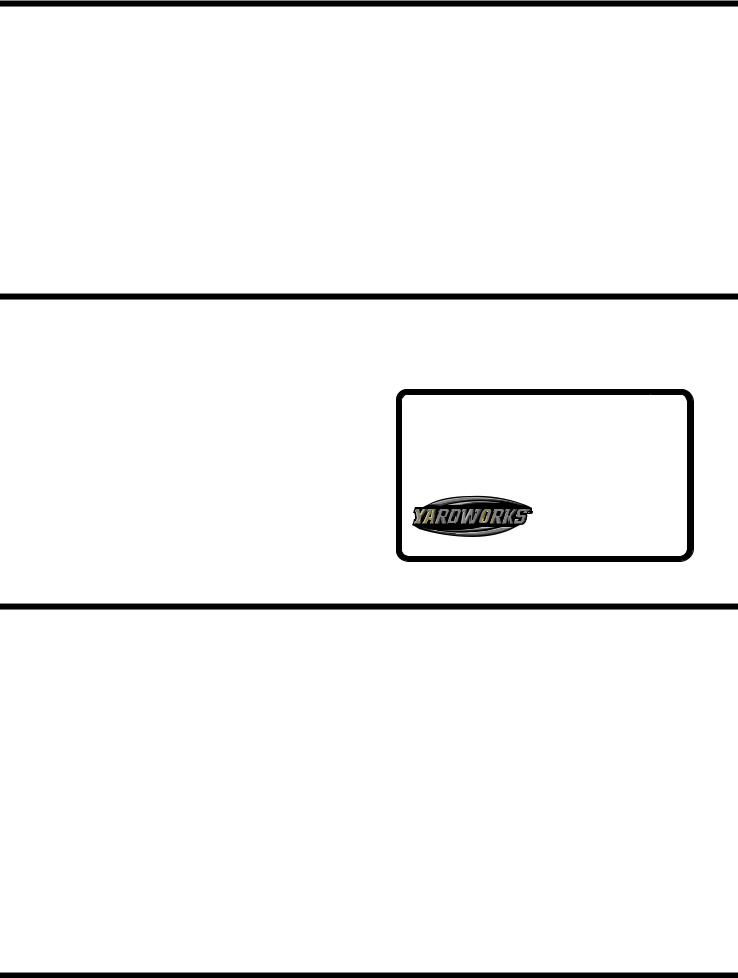
This Owner’s Manual is an important part of this piece of equipment. It will help you to assemble, prepare, and maintain this product for best performance. Please read it carefully, and ensure that you understand what it says.
Table of Contents
Slope Gauge........................................................ |
3 |
Trouble Shooting............................................... |
12 |
Safe Operation Practices.................................... |
4 |
Warranty............................................................. |
13 |
Set-Up & Adjustments........................................ |
6 |
Illustrated Parts Lists........................................ |
14 |
Operation............................................................. |
8 |
EZ Start Promise™............................................ |
16 |
Maintenance & Off-Season Storage................ |
10 |
|
|
Finding and Recording the Model Number
BEFORE ASSEMBLING THIS PRODUCT, find the model plate on the product, and write the model number and the serial number on the sample model plate provided to the right. Locate the model plate by standing at the operating position and looking down at the rear of the product.
Model Number |
Serial Number |
Numéro de modèle |
Numéro de série |
|
|
XXXXXXXXXX |
XXXXXXXXXXX |
|
YARDWORKS |
|
TORONTO, ONT. M4S 2B8 |
|
1-866-523-5218 |
Customer Support
Please do NOT return the unit to the retailer from which it was purchased, without contacting Customer Support first.
If you have difficulty assembling this product, or if you have any questions concerning the controls, operation, or maintenance of this product, please contact Customer Support, at 1-866-523-5218.
Have the model number and serial number of the product ready when you call. See the preceding section for information on how to locate this information.
You will be asked to enter the serial number in order to process your call.
The engine manufacturer is responsible for all engine-related issues in terms of performance, power-rating, specifications, warranty, and service. Depending on the engine manufacturer, more information is included in this publication or packed separately with this product.
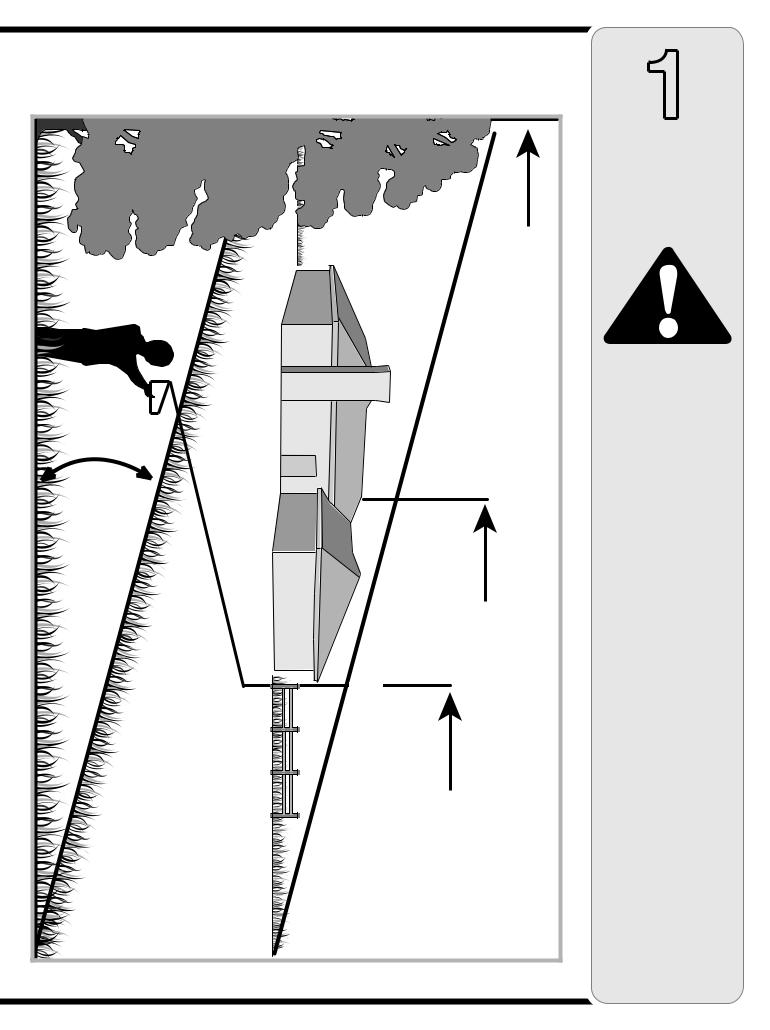
Use this page as a guide to determine slopes where you may not operate safely. Do not operate your lawn mower on such slopes.
15° |
|
|
|
|
|
Fold |
vertical a with level this hold and Sight |
|
|
|
|
|
along |
...tree |
|
|
|
|
|
|
|
||
|
|
|
|
dotted |
|
a or |
|
|
|
|
|
|
|
||
|
|
|
line |
|
|
corner |
|
|
|
|
|
|
|
||
|
|
(represents |
|
|
|
...building a of a or |
|
|
a |
|
|
|
|
||
|
|
|
|
|
|
fence |
|
slope) |
15° |
|
|
|
|
|
|
|
|
|
|
|
post |
||
|
|
|
|
|
|
1
Slope Gauge
WARNING
Do not mow on inclines with a slope in excess of 15 degrees (a rise of approximately
2-1/2 feet every 10 feet). A riding mower could overturn and cause serious injury.
If operating a walkbehind mower on such a slope, it is extremely difficult to maintain your footing and you could slip, resulting in serious injury.
Operate RIDING mowers up and down slopes, never across the face of slopes.
Operate WALK-BEHIND mowers across the face of slopes, never up and down slopes.
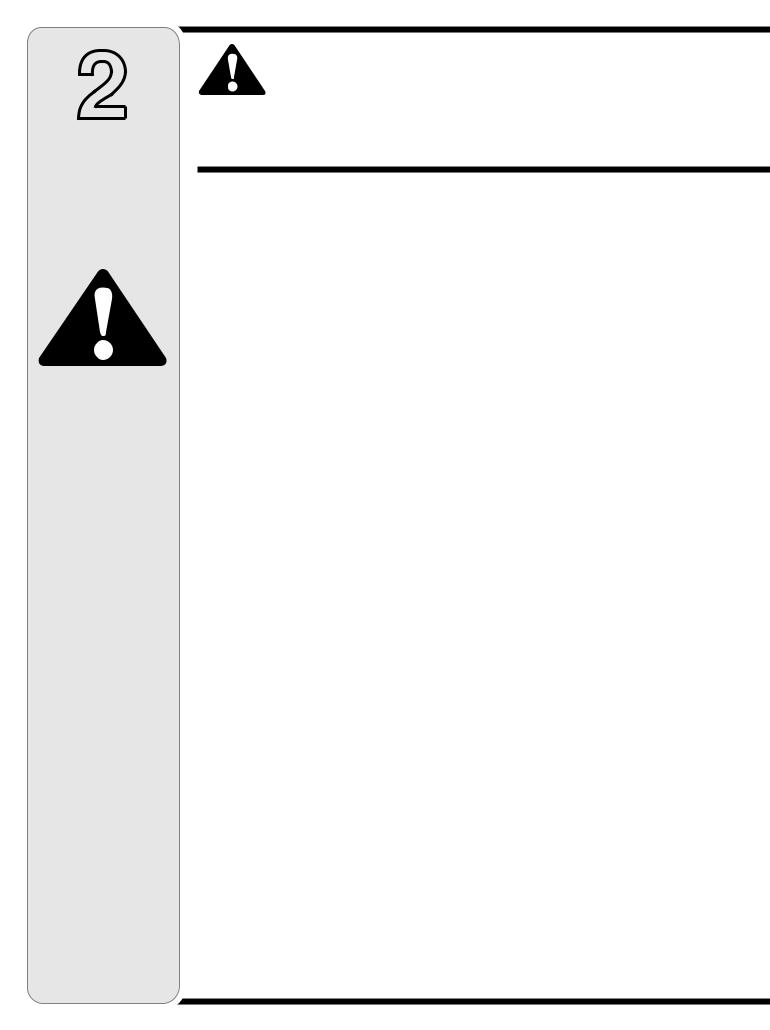
2
Safe
Operation Practices
WARNING
This symbol points out important safety instructions which, if not followed, could endanger the personal safety and/or property of yourself and others.
Read and follow all instructions in this manual before attempting to operate this machine. Failure to comply with these instructions may result
in personal injury. When you see this symbol.
HEED ITS WARNING!
Your Responsibility
Restrict the use
of this power machine to persons who read, understand
and follow the warnings and instructions
in this manual
and on the machine.
WARNING: Engine Exhaust, some of its constituents, and certain vehicle components contain or emit chemicals known to the State of California to cause cancer and birth defects or other reproductive harm.
DANGER: This machine was built to be operated according to the rules for safe operation in this manual. As with any type of power equipment, carelessness or error on the part of the operator can result in serious injury. This machine is capable of amputating hands and feet and throwing objects. Failure to observe the following safety instructions could result in serious injury or death.
General Operation
1.Read this operator’s manual carefully in its entirety before attempting to assemble this machine. Read, understand, and follow all instructions on the machine and in the manual(s) before operation. Keep this manual in a safe place for future and regular reference and for ordering replacement parts.
2.Be completely familiar with the controls and the proper use of this machine before operating it.
3.This machine is a precision piece of power equipment, not a plaything. Therefore, exercise extreme caution at all times. Your unit has been designed to perform one job: to mow grass. Do not use it for any other purpose.
4.Never allow children under 14 years old to operate this machine. Children 14 years old and over should read and understand the instructions in this manual and should be trained and supervised by a adult.
5.Only responsible individuals who are familiar with these rules of safe operation should be allowed to use this machine.
6.Thoroughly inspect the area where the equipment is to be used. Remove all stones, sticks, wire, bones, toys and other foreign objects which could be tripped over or picked up and thrown by the blade. Thrown objects can cause serious personal injury.
7.Plan your mowing pattern to avoid discharge of material toward roads, sidewalks, bystanders and the like. Also, avoid discharging material against a wall or obstruction which may cause discharged material to ricochet back toward the operator.
8.To help avoid blade contact or a thrown object injury, stay in the operator zone behind the handles and keep children,
bystanders, helpers and pets at least 75 feet from the mower while it is in operation. Stop machine if anyone enters the area.
9.Always wear safety glasses or safety goggles during operation and while performing an adjustment or repair to protect your eyes. Thrown objects which ricochet can cause serious injury to the eyes.
10.Wear sturdy, rough-soled work shoes and close-fitting slacks and shirts. Shirts and pants that cover the arms and legs and steel-toed shoes are recommended. Never operate this machine in bare feet, sandals, slippery or light weight (e.g. canvas) shoes.
11.Do not put hands or feet near rotating parts or under the cutting deck. Contact with the blade can amputate hands and feet.
12.A missing or damaged discharge cover can cause blade contact or thrown object injuries.
13.Many injuries occur as a result of the mower being pulled over the foot during a fall caused by slipping or tripping. Do not hold on to the mower if you are falling; release the handle immediately.
14.Never pull the mower back toward you while you are walking. If you must back the mower away from a wall or obstruction first look down and behind to avoid tripping and then follow these steps:
a.Step back from the mower to fully extend your arms.
b.Be sure you are well balanced with sure footing.
c.Pull the mower back slowly, no more than half way toward you.
d.Repeat these steps as needed.
15. Do not operate the mower while under the influence of alcohol or drugs.
16.Do not engage the self-propelled mechanism on units so equipped while starting engine.
17.The blade control handle is a safety device. Never attempt to bypass its operation. Doing so makes the safety device
inoperative and may result in personal injury through contact with the rotating blade. The blade control handle must operate easily in both directions and automatically return to the disengaged position when released.
18.Never operate the mower in wet grass. Always be sure of your footing. A slip and fall can cause serious personal injury. If you feel you are losing your footing, release the blade control handle immediately and the blade will stop rotating within three seconds.
19.Mow only in daylight or in good artificial light. Walk, never run.
20.Stop the blade when crossing gravel drives, walks or roads.
21.If the equipment should start to vibrate abnormally, stop the engine and check immediately for the cause. Vibration is generally a warning of trouble.
22.Shut the engine off and wait until the blade comes to a complete stop before removing the grass catcher or unclogging the chute. The cutting blade continues to rotate for a few seconds after the engine is shut off. Never place any part of the body in the blade area until you are sure the blade has stopped rotating.
23.Never operate mower without proper trail shield, discharge cover, grass catcher, blade control handle or other safety protective devices in place and working. Never operate mower with damaged safety devices. Failure to do so, can result in personal injury.
24.Muffler and engine become hot and can cause a burn. Do not touch.
25.Never attempt to make a wheel or cutting height adjustment while the engine is running.
26.Only use parts and accessories made for this machine by the manufacturer. Failure to do so can result in personal injury.
27.When starting engine, pull cord slowly until resistance is felt, then pull rapidly. Rapid retraction of starter cord (kickback) will pull hand and arm toward engine faster than you can let go. Broken bones, fractures, bruises or sprains could result.
28.If situations occur which are not covered in this manual, use care and good judgment. Call customer assistance for the name of your nearest servicing dealer.
Slope Operation
Slopes are a major factor related to slip and fall accidents which can result in severe injury. Operation on slopes requires extra caution. If you feel uneasy on a slope, do not mow it. For your safety, use the slope gauge included as part of this manual to measure slopes before operating this unit on a sloped or hilly area. If the slope is greater than 15 degrees, do not mow it.
Do:
1.Mow across the face of slopes; never up and down. Exercise extreme caution when changing direction on slopes.
2.Watch for holes, ruts, rocks, hidden objects, or bumps which can cause you to slip or trip. Tall grass can hide obstacles.

3.Always be sure of your footing. A slip and fall can cause serious personal injury. If you feel you are losing your balance, release the blade control handle immediately, and the blade will stop rotating within 3 seconds.
Do Not:
1.Do not mow near drop-offs, ditches or embankments, you could lose your footing or balance.
2.Do not mow slopes greater than 15 degrees as shown on the slope gauge.
3.Do not mow on wet grass. Unstable footing could cause slipping.
Children
Tragic accidents can occur if the operator is not alert to the presence of children. Children are often attracted to the mower and the mowing activity. They do not understand the dangers. Never assume that children will remain where you last saw them.
1.Keep children out of the mowing area and under the watchful care of a responsible adult other than the operator.
2.Be alert and turn mower off if a child enters the area.
3.Before and while moving backwards, look behind and down for small children.
4.Use extreme care when approaching blind corners, doorways, shrubs, trees, or other objects that may obscure your vision of a child who may run into the mower.
5.Keep children away from hot or running engines. They can suffer burns from a hot muffler.
6.Never allow children under 14 years old to operate a power mower. Children 14 years old and over should read and understand the operation instructions and safety rules in this manual and should be trained and supervised by a parent.
Service
Safe Handling Of Gasoline:
1.To avoid personal injury or property damage use extreme care in handling gasoline. Gasoline is extremely flammable and the vapors are explosive. Serious personal injury can occur when gasoline is spilled on yourself or your clothes which can ignite. Wash your skin and change clothes immediately.
2.Use only an approved gasoline container.
3.Never fill containers inside a vehicle or on a truck or trailer bed with a plastic liner. Always place containers on the ground away from your vehicle before filling.
4.Remove gas-powered equipment from the truck or trailer and refuel it on the ground. If this is not possible, then refuel such equipment on a trailer with a portable container, rather than from a gasoline dispenser nozzle.
5.Keep the nozzle in contact with the rim of the fuel tank or container opening at all times until fueling is complete. Do not use a nozzle lock-open device.
6Extinguish all cigarettes, cigars, pipes and other sources of ignition.
7.Never fuel machine indoors because flammable vapors will accumulate in the area.
8.Never remove gas cap or add fuel while the engine is hot or running. Allow engine to cool at least two minutes before refueling.
9.Never over fill fuel tank. Fill tank to no more than ½ inch below bottom of filler neck to provide for fuel expansion.
10.Replace gasoline cap and tighten securely.
11.If gasoline is spilled, wipe it off the engine and equipment. Move unit to another area. Wait 5 minutes before starting the engine.
12.Never store the machine or fuel container near an open flame, spark or pilot light as on a water heater, space heater, furnace, clothes dryer or other gas appliances.
13.To reduce fire hazard, keep mower free of grass, leaves, or other debris build-up. Clean up oil or fuel spillage and remove any fuel soaked debris.
14.Allow a mower to cool at least 5 minutes before storing.
General Service:
1.Never run an engine indoors or in a poorly ventilated area. Engine exhaust contains carbon monoxide, an odorless and deadly gas.
2.Before cleaning, repairing, or inspecting, make certain the blade and all moving parts have stopped. Disconnect the spark plug wire and ground against the engine to prevent unintended starting.
3.Check the blade and engine mounting bolts at frequent intervals for proper tightness. Also, visually inspect blade for damage (e.g., bent, cracked, worn) Replace blade with the original equipment manufacture’s (O.E.M.) blade only, listed in this manual. “Use of parts which do not meet the original equipment specifications may lead to improper performance and compromise safety!”
4.Mower blades are sharp and can cut. Wrap the blade or wear gloves, and use extra caution when servicing them.
5.Keep all nuts, bolts, and screws tight to be sure the equipment is in safe working condition.
6.Never tamper with safety devices. Check their proper operation regularly.
7.After striking a foreign object, stop the engine, disconnect the spark plug wire and ground against the engine. Thoroughly inspect the mower for any damage. Repair the damage before starting and operating the mower.
8.Never attempt to make a wheel or cutting height adjustment while the engine is running.
9.Grass catcher components, discharge cover, and trail shield are subject to wear and damage which could expose moving parts or allow objects to be thrown. For safety protection, frequently check components and replace immediately with original equipment manufacturer’s (O.E.M.) parts only, listed in this manual. “Use of parts which do not meet the original equipment specifications may lead to improper performance and compromise safety!”
10.Do not change the engine governor setting or overspeed the engine. The governor controls the maximum safe operating speed of the engine.
11.Check fuel line, tank, cap, and fittings frequently for cracks or leaks. Replace if necessary.
12.Do not crank engine with spark plug removed.
13.Maintain or replace safety labels, as necessary.
14.Observe proper disposal laws and regulations. Improper disposal of fluids and materials can harm the environment.
Do not modify engine
To avoid serious injury or death, do not modify engine in any way. Tampering with the governor setting can lead to a runaway engine and cause it to operate at unsafe speeds. Never tamper with factory setting of engine governor.
Average Useful Life
According to the Consumer Products Safety Commission (CPSC) and the U.S. Environmental Protection Agency (EPA), this product has an Average Useful Life of seven (7) years, or 60 hours of operation. At the end of the Average Useful Life, buy a new machine or have the machine inspected annually by an authorized service dealer to ensure that all mechanical and safety systems are working properly and not worn excessively. Failure to do so can result in accidents, injuries or death.
2
Safe
Operation Practices
WARNING
This machine is equipped with an internal combustion engine and should not be used on or near any unimproved forestcovered, brushcovered or grass-covered land unless the engine’s exhaust system is equipped with a spark arrester meeting applicable local or provincial laws (if any).
If a spark arrester is used, it should be maintained in effective working order by the operator.
A spark arrester for the muffler is available through your nearest engine authorized service dealer.
Notice regarding Emissions
Engines which are certified to comply with California and federal EPA emission regulations for SORE (Small Off Road Equipment) are certified to operate on regular unleaded gasoline, and may include the following emission control systems: Engine Modification (EM) and Three Way Catalyst (TWC) if so equipped.
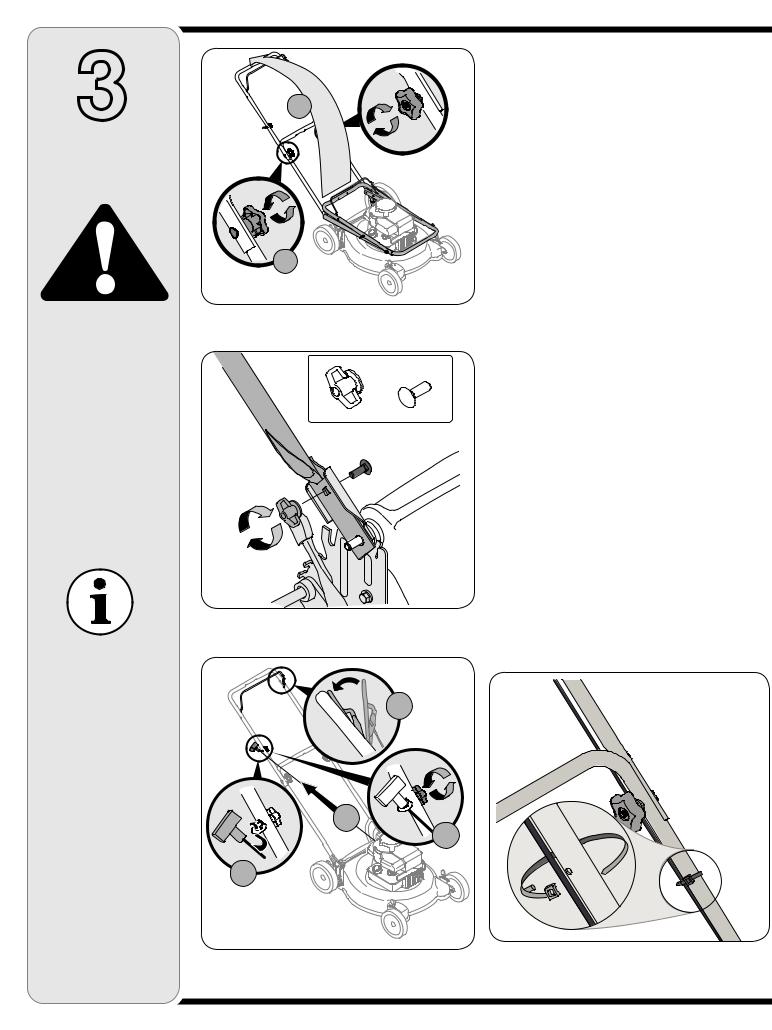
3
Setup and Adjustments
WARNING
Disconnect and ground the spark plug wire as instructed in the separate engine manual.
IMPORTANT This unit is shipped WITHOUT GASOLINE or OIL. After assembly, service engine with gasoline and
oil as instructed in the separate engine manual packed with your unit.
A
B
Figure 3-1
Figure 3-2
A
B
D
C
NOTE: The units illustrated may vary slightly from your unit.
1.Remove any packing material which may be between upper and lower handles.
a.Pull up and back on the upper handle to raise the handle from position A into the operating position. See Figure 3-1.
b.Tighten hand knobs securing upper handle to lower handle. Make sure that each carriage bolt is seated properly in the handle.
2.Place one carriage bolt (found in the hardware pack included with your unit) in the upper hole of the right handle mounting bracket from the inside outward. See Figure 3-2. Secure with one wing nut. Repeat process on the left side.
3.Rope guide Setup as follows, see Figure 3-3:
a.Hold the blade control against the upper handle. Position A.
b.Slowly pull starter rope out of engine. Position B.
c.Slip starter rope into the rope guide. Position C.
d.Tighten rope guide wing nut .Position D.
4.Insert post on cable tie into hole provided on the lower handle. Pull cable tie tight and trim excess. See Figure 3-4.
5.Each wheel has a height adjustment lever to change the cutting height of the mower. To change the height of cut, squeeze adjuster lever toward the wheel, moving up or down to selected height. See Figure 3-5.
Figure 3-3 |
Figure 3-4 |
|
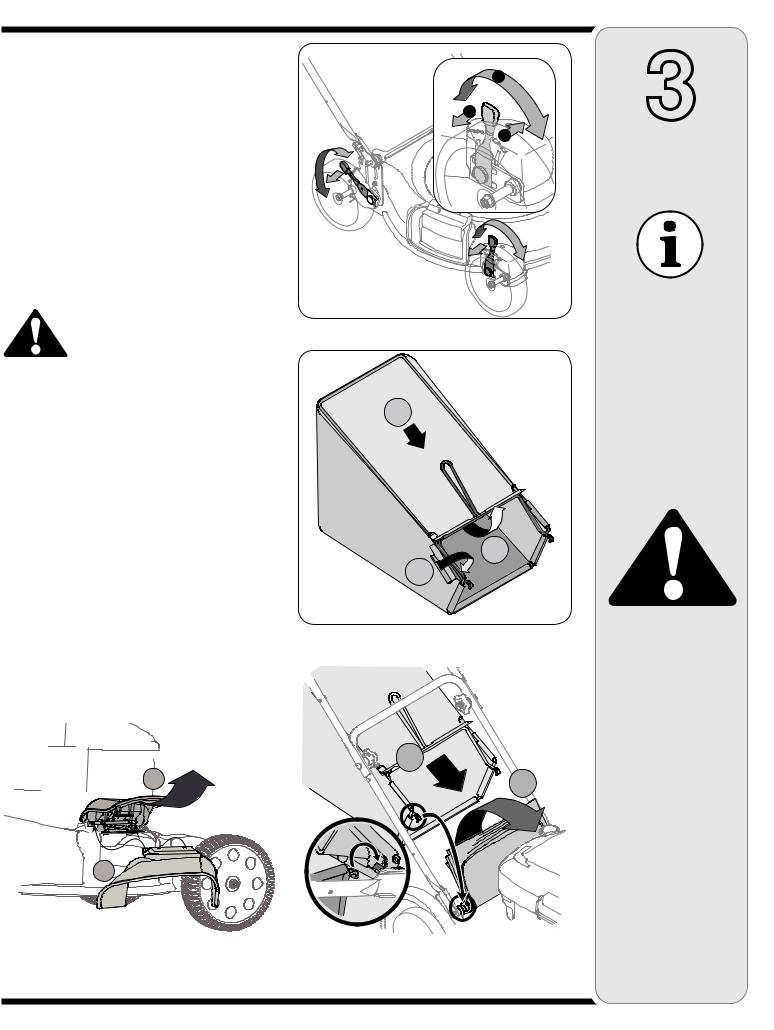
6. To assemble the grasscatcher:
a. Place bag over frame (black plastic side is the |
|
3 |
|
bottom of bag.) Insert the hooks on the frame |
|||
|
|||
through the holes in the side plastic channels of |
|
||
the bag. See Figure 3-6. |
|||
|
|||
b. Secure bag to frame by working the plastic chan- |
Setup and |
||
nels on bag over frame as shown in Figure 3-6. |
|
||
All of the plastic channels except center top of bag |
|
Adjustments |
|
attach from the outside of bag. Center top of bag |
|
||
attaches from the inside of bag. |
|
|
|
7. Attaching Grass Catcher to Mower |
|
|
|
a. Lift the rear discharge door on the mower, and |
|
|
|
place the grass catcher on the pivot rod. Let go |
|
|
|
of discharge door so that it rests on the grass |
|
|
|
catcher. See Figure 3-7. |
|
NOTE: Make certain |
|
WARNING: Never operate mower |
|
||
Figure 3-5 |
bag is turned right side |
||
unless the hooks on the grass |
out before assembling |
||
catcher are firmly seated on the |
|
(warning label will be on |
|
pivot rod, and the rear discharge |
|
the outside). |
|
door rests firmly against top of |
|
NOTE: Make certain |
|
the grass catcher. |
! |
||
cables are routed to the |
|||
8. To remove grass catcher and utilize the mulching |
|
||
|
outside of the handle so |
||
feature: |
|
||
|
they are not in the way |
||
a. Lift rear discharge door on the mower as shown in |
|
||
|
when attaching the grass |
||
Figure 3-7. Lift grass catcher up and out, off of the |
|
catcher. |
|
pivot rod. Release rear discharge door to allow it to |
|
||
|
|
||
close rear opening of mower. |
|
|
|
9. The side discharge is an optional feature. |
# |
|
|
If converting to side discharge, make sure grass |
|
||
catcher is off unit and rear discharge door is closed. |
" |
|
|
a. On the side of the mower deck, lift the hinged |
|
|
|
mulching plug. See Figure 3-8. |
|
WARNING |
|
b. Slide the two hooks on the side discharge deflec- |
Figure 3-6 |
||
tor under the hinge pin on the hinged mulching |
Never operate mower |
||
plug assembly. Lower the hinged mulching plug. |
|
||
NOTE: Do not remove the hinged mulching plug at any |
|
unless the hooks on |
|
time, even when you are not mulching. |
|
the grass catcher are |
|
|
|
firmly seated on the |
|
|
|
pivot rod, and the |
|
|
B |
rear discharge door |
|
|
rests firmly against |
||
! |
A |
top of the grass |
|
|
|
catcher. |
|
|
|
All mowers are |
|
|
|
equipped with a rear |
|
" |
|
protective guard. The |
|
|
|
guard helps eliminate |
|
|
|
projectiles thrown |
|
|
|
by the blade from |
|
|
|
injuring the operator. |
|
Figure 3-8 - Optional Feature |
Figure 3-7 |
DO NOT REMOVE |
|
|
|
THIS GUARD. |
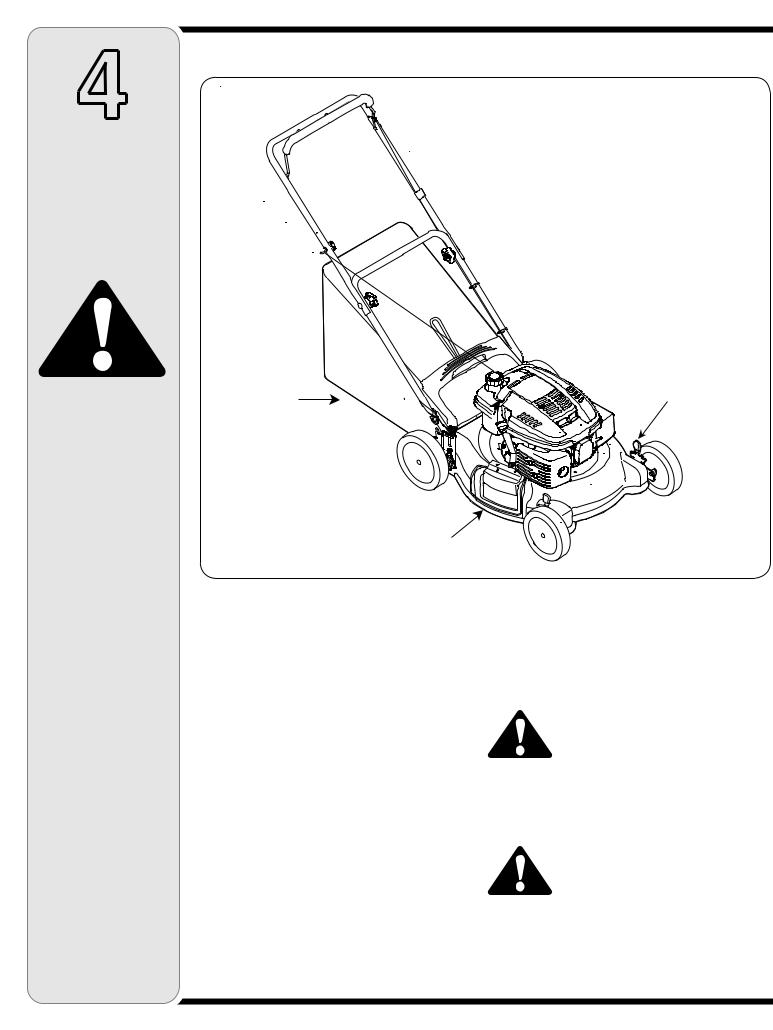
4
Operating
Your Lawn
Mower
WARNING
Read, understand, and follow all instructions and warnings on the machine and in this manual before operating.
This blade control mechanism is a safety device. Never attempt to bypass its operations.
Use extreme care when handling gasoline. Gasoline is extremely flammable and the vapors are explosive. Never fuel the machine indoors or while the engine is hot or running. Extinguish cigarettes, cigars, pipes and other sources of ignition.
Know Your Lawn Mower
 Blade Control
Blade Control
Recoil
Starter


|
Cutting Height |
|
Adjustment Lever |
Grass |
(for each wheel) |
Catcher |
|
Mulch Plug (optional)
Figure 4-1
NOTE: The units illustrated may vary slightly from your unit.
Blade Control Handle
The blade control handle is located on the upper handle of the mower. See Figure 4-1. The blade control handle must be depressed in order to operate the unit. Release the blade control handle to stop the engine and blade.
Recoil Starter
The recoil starter is attached to the right upper handle. Stand behind the unit and pull the recoil starter rope to start the unit.
Mulching Plug (optional)
The mulching plug is used to close the side discharge chute opening when mulching or bagging grass. Do not remove the hinged mulching plug at any time, even when you are not mulching.
Cutting Height Adjustment Levers (If so equipped)
One adjustment lever is located on each wheel and is used to adjust the cutting height. All four levers have to be at the same relative position to ensure uniform cut.
Gas and Oil Fill-Up
1.Add oil provided before starting unit for the first time out of the box.
2.Service the engine with gasoline as instructed in the separate engine manual packed with your unit.
WARNING: Use extreme care when handling gasoline. Gasoline is extremely flammable and the vapors are explosive. Never fuel the machine indoors or while the engine is hot or running. Extinguish cigarettes, cigars, pipes and other sources of ignition.
WARNING: The operation of any lawn mower can result in foreign objects being thrown into the eyes, which can damage your eyes severely. Always wear safety glasses while operating the mower, or while performing any adjustments or repairs on it.
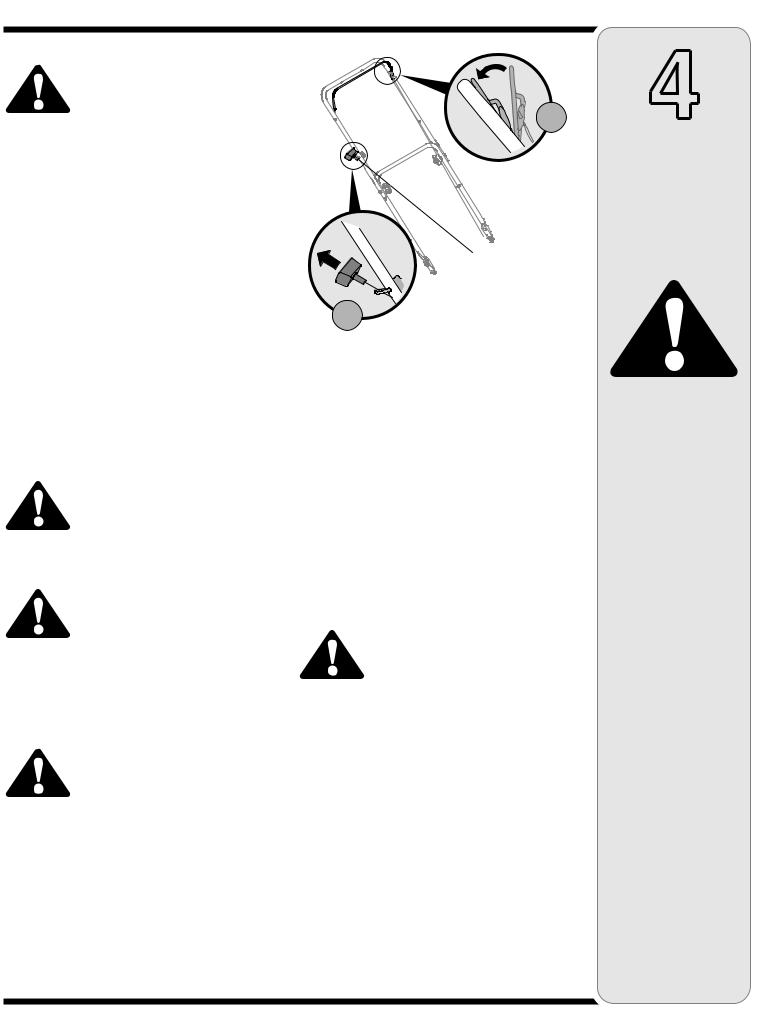
Starting Engine
WARNING: Be sure no one other than the operator is standing near the lawn mower while starting engine or operating mower. Never run engine indoors or in enclosed, poorly ventilated areas. Engine exhaust contains carbon monoxide, an odorless and deadly gas. Keep hands, feet, hair and loose clothing away from any moving parts on engine and lawn mower.
1.Standing behind the mower, squeeze and hold the blade control against upper handle, Figure 4-2.
2.Grasp the starter handle as shown and pull slowly until resistance is felt, then pull rapidly to start engine and avoid kickback. Return it slowly to the rope guide.
Important: Do not allow the recoil starter to snap back against the rope guide.
Stopping Engine
1.Release blade control handle to stop the engine and the blade.
2.Disconnect spark plug wire from spark plug and ground against the engine.
WARNING: Wait for the blade to stop completely before performing any work on the mower or to remove the grass catcher.
Using Your Lawn Mower
WARNING: Never operate your mower without either the rear door or the entire grass catcher assembly firmly secured.
Be sure the lawn is clear of stones, sticks, wire, or other objects which could damage the lawn mower or the engine. Such objects could be accidently thrown by the mower in any direction and cause serious personal injury to the operator and others.
WARNING: If you strike a foreign object, stop the engine. Remove wire from the spark plug, thoroughly inspect the mower for any damage, and repair the damage before restarting and operating the mower. Extensive vibration of the mower during operation is an indication of damage. The unit
should be promptly inspected and repaired.
1
2
Figure 4-2
Operating Tips
1.For best results and effective mulching, do not cut wet grass.
2.New grass, thick grass, or wet grass may require a narrower cut.
3.For a healthier lawn, never cut off more than onethird of the total length of the grass.
4.Your lawn should be cut in the fall as long as there is growth.
5.Adjust ground speed according to condition of lawn.
6.If the grass has been allowed to grow in excess of 4 inches, mulching is not recommended. Mow using the grass catcher to reduce the grass height to 3-1/4 inches or less before mulching.
WARNING: Wait for the blade to stop completely before doing any work on the mower or to remove the grass catcher.
NOTE: To operate your unit using the grass catcher, mulcher or optional side discharge refer to page 7.
4
Operating
Your Lawn
Mower
WARNING
The operation of any lawn mower can result in foreign objects being thrown into
the eyes, which can damage your eyes severely. Always wear safety glasses while operating the mower, or while performing any adjustments or repairs on it.
Be sure no one other than the operator is standing near the lawn mower while starting engine or operating mower. Never run engine indoors or
in enclosed, poorly ventilated areas. Engine exhaust contains carbon monoxide, an odorless and deadly gas. Keep hands, feet, hair and loose clothing away from any moving parts on engine and lawn mower.

5
Maintenance
WARNING
Always stop engine, disconnect spark plug, and ground against engine before cleaning, lubricating or doing any kind of maintenance on your machine.
We do not recommend the use of pressure washers or garden hose to clean your unit. These may cause damage to electrical components, spindles, pulleys, bearings, or the engine. The use of water will result in shortened life and reduce serviceability.
Lubricate these points before reassembly.
Figure 5-1
General Recommendations
1.Always observe safety rules when performing any maintenance.
2.The warranty on this lawn mower does not cover items that have been subjected to operator abuse or negligence. To receive full value from warranty, operator must maintain the lawn mower as instructed here.
3.Changing of engine-governed speed will void engine warranty.
4.All adjustments should be checked at least once each season.
5.Periodically check all fasteners and make sure these are tight.
Lubrication
1.Lubricate the pivot points on the blade control handle at least once a season with light oil. The blade control must operate freely in both directions. See Figure 5-1.
2.If your mower is equipped with ball bearing wheels, lubricate at least once a season with a light oil, all other types require no lubrication. However, if the wheels are removed for any reason, lubricate the surface of the axle bolt and the inner surface of the wheel with light automotive oil.
3.Lubricate the torsion spring and pivot points periodically with light oil to prevent rust. See Figure 5-1.
Engine
1.Refer to the separate engine manual for engine maintenance instructions.
2.Maintain engine oil as instructed in the separate engine manual packed with your unit. Read and follow instructions carefully.
3.Service air cleaner every 25 hours under normal conditions. Clean every few hours under extremely dusty conditions.
4.Clean the engine regularly with a cloth or brush. Keep the cooling system (blower housing area) clean to permit proper air circulation which is essential to engine performance and life. Be certain to remove all grass, dirt and combustible debris from muffler area.
Deck
The underside of the mower deck should be cleaned after each use to prevent a buildup of grass clippings, leaves, dirt or other matter. If this debris is allowed to accumulate, it will invite rust and corrosion, and may prevent proper mulching.
The deck may be cleaned by tilting the mower and scraping clean with a suitable tool (make certain the spark plug wire is disconnected).
Blade Care
WARNING: When removing the cutting blade for sharpening or replacement, protect your hands with a pair of heavy gloves or use a heavy rag to hold the blade.
Periodically inspect the blade adapter for cracks, especially if you strike a foreign object. Replace when necessary. Follow the steps below for blade service:
1.Disconnect spark plug wire from spark plug.
2.Tip mower as specified in separate engine manual. If it does not specify turn mower on its side making sure that the air filter and the carburetor are up.
3.Remove the bolt and the blade bell support which hold the blade and the blade adapter to the engine crankshaft. See Figure 5-1.
4.Remove blade and adapter from the crankshaft.
5.The blade may be resharpened by removing it and either grinding or filing the cutting edge keeping as close to the original bevel as possible. Do not attempt to sharpen the blade while it is still on the mower.
6.It is extremely important that each cutting edge receives an equal amount of grinding to prevent an unbalanced blade.
NOTE: Improper blade balance will result in excessive vibration causing eventual damage to the engine and mower. Be sure to carefully balance blade after sharpening. Possible damage resulting from blade unbalance condition is not the responsibility of the manufacturer.
10
